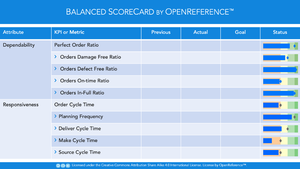A109
Difference between revisions of "A109"
| Line 1: | Line 1: | ||
| − | The activities associated with the selection of the key metrics for each performance attribute for each supply chain. A scorecard is used to define the metrics of most interest to an organization, to arrange them by area of impact, by | + | The activities associated with the selection of the key metrics for each performance attribute for each supply chain. A scorecard is used to define the metrics of most interest to an organization, to arrange them by area of impact, by business priority, and to provide a container for later benchmarking comparisons. Each scorecard is built from a subset of hundreds of {{OR}} metrics. |
[[File:OR-BSC.png|thumb|Balanced Scorecard example]] | [[File:OR-BSC.png|thumb|Balanced Scorecard example]] | ||
===Notes=== | ===Notes=== | ||
| − | The [[sc:A102|discovery (A102)]] and [[sc:A108|documentation/definition (A108)]] of supply chains are a key preceding steps. Without clearly defined supply chains, scorecards may contain aggregate data of conflicting supply chain types e.g. [[Link::t:MTO]] and [[Link::t:MTS]] together. | + | [[sc:A101|Busines plan review]] is a key step prior to defining scorecards. Without a deep understanding of the business plan, metrics are typically not --clearly-- linked to business priorities. |
| + | The [[sc:A102|discovery (A102)]] and [[sc:A108|documentation/definition (A108)]] of supply chains are a key preceding steps. Without clearly defined supply chains, scorecards may contain aggregate data of conflicting supply chain types e.g. [[Link::t:MTO]] and [[Link::t:MTS]] together. | ||
| + | |||
| + | The {{OR}} wiki provides all necessary definitions. [[Category:Process]][[Category:Supply Chain]] | ||
{{Object | {{Object | ||
|name=Define Scorecard | |name=Define Scorecard | ||
Revision as of 16:30, 17 November 2021
The activities associated with the selection of the key metrics for each performance attribute for each supply chain. A scorecard is used to define the metrics of most interest to an organization, to arrange them by area of impact, by business priority, and to provide a container for later benchmarking comparisons. Each scorecard is built from a subset of hundreds of OpenReference metrics.
Contents
Notes
Busines Plan Review is a key step prior to defining scorecards. Without a deep understanding of the business plan, metrics are typically not --clearly-- linked to business priorities. The Discovery (A102) and Documentation/definition (A108) of supply chains are a key preceding steps. Without clearly defined supply chains, scorecards may contain aggregate data of conflicting supply chain types e.g. Make-to-Order and Make-to-Stock together.
The OpenReference wiki provides all necessary definitions.
Workflow
| Process |
| ||||||||||||||||||
|---|---|---|---|---|---|---|---|---|---|---|---|---|---|---|---|---|---|---|---|---|
|
A109 |
|
||||||||||||||||||
